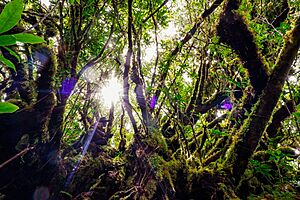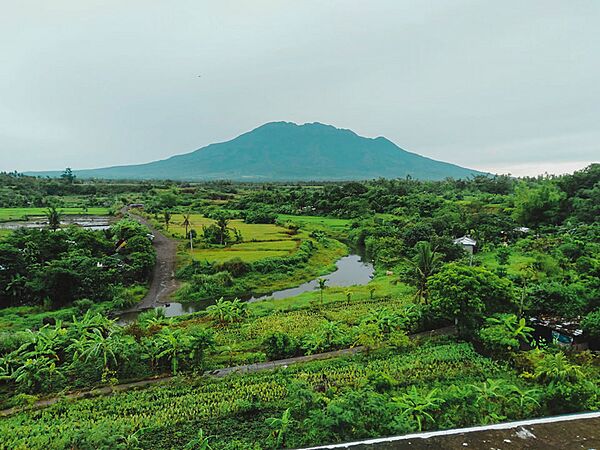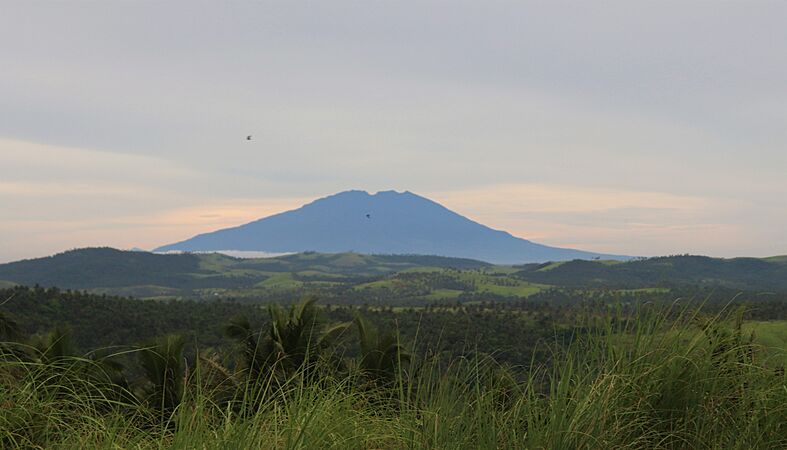Mount Isarog facts for kids
Quick facts for kids Mount Isarog |
|
|---|---|

Mt. Isarog viewed from Baao, Camarines Sur
|
|
| Highest point | |
| Elevation | 2,011.6 m (6,600 ft) |
| Prominence | 1,951 m (6,401 ft) |
| Parent peak | Mayon |
| Listing |
|
| Geography | |
| Country | Philippines |
| Region | Bicol Region |
| Province | Camarines Sur |
| City/municipality |
|
| Geology | |
| Mountain type | Stratovolcano |
| Volcanic arc/belt | Bicol Volcanic Chain |
| Last eruption | 2,374 BCE ± 87 years 3,500 BCE ± 125 years (5,500 ya ± 125 years) |
| Climbing | |
| Easiest route | Concosep, Tigaon, Camarines Sur Route |
Mount Isarog is an active volcano in the Philippines. It is located in the province of Camarines Sur on the island of Luzon. This mountain is a type of volcano called a stratovolcano.
Mount Isarog has active fumaroles (gas vents) and hot springs. It stands about 2,011.6 meters (6,599.7 feet) tall. The mountain is found on a wide strip of land between Lagonoy Gulf and San Miguel Bay.
The volcano has a large crater, about 2,500 meters (8,202 feet) wide. This crater is open on its east side, forming a narrow valley. A big pile of rock and debris from the volcano stretches northwest towards the coast and into San Miguel Bay.
The top of Mount Isarog is a special point where the borders of six towns and one city meet. These places are Goa, Tigaon, Ocampo, Pili, Naga City, Tinambac, and Calabanga.
During the Japanese Occupation in the past, Mount Isarog was a hiding place. Local soldiers and Filipino fighters used the mountain to stay safe.
Contents
History of Mount Isarog
Ancient History
For thousands of years, Mount Isarog has been the home of the Isarog Agta people. They are an indigenous group, meaning they were among the very first people to live in the Philippines. They are part of the Negrito people and have their own special language and traditions.
Protecting the Mountain
Mount Isarog has been officially protected by the government for many years. In 1935, it was made a forest reserve. Later, President Manuel L. Quezon declared it a National Park. This helped protect its natural beauty and wildlife.
In 2002, President Gloria Macapagal-Arroyo signed a new law. This law made Mount Isarog a protected area under the "natural park" category. This means it is a special place where nature is carefully preserved.
Volcano Eruptions
Mount Isarog has erupted in the past. Scientists have found evidence that it erupted around 3,500 BCE (Before Common Era). More recently, in 2020, geologists discovered that it also erupted about 4,300 years ago. They found charcoal under thick ash and rock, which helped them figure out the date.
Today, the volcano is not erupting. But it still shows signs of activity. There are gas vents, warm springs, and steaming spots on the mountain.
Earthquakes Near the Volcano
In 1915, people felt many earthquakes around Mount Isarog. There were also loud noises. Some parts of the mountain experienced landslides. These earthquakes happened several times until early 1916. Even though the volcano was covered in thick trees, no one saw any steam vents at that time.
People of Isarog
The Isarog Agta Tribe
The Isarog Agta people live around Mount Isarog. They are one of the original Negrito groups in the Philippines. They have their own unique language and culture.
Sadly, their language is in danger. In 2010, UNESCO said that the Isarog Agta language was "Critically Endangered." This means that only a few older people still speak it, and they don't often teach it to their children or grandchildren. If this continues, their special language could disappear in the next 10 to 20 years.
Amazing Nature
Mount Isarog is home to many different kinds of plants and animals. It has four main types of natural areas, or habitats:
| Types of Forest | Height Above Sea Level |
|---|---|
| Lowland Forest | 500-900 meters |
| Grassland | 700-1,200 meters |
| Montane Forest | 1,000-1,400 meters |
| Mossy Forest | 1,500 meters to the top |
The Lowland Forest has very tall trees, some reaching up to 60 meters (nearly 200 feet)! Many of these trees belong to the dipterocarp family. You can also find bamboos, palms, and climbing plants like orchids and ferns here.
The Grassland areas are mostly covered by tall grasses like cogon and talahib. Trees don't grow well here because of the type of land and soil.
The Montane Forest has trees that are shorter, usually 12–25 meters tall. There are more open spaces between the trees here.
The Mossy Forest is found near the top of the mountain. The trees here are much shorter, only 2 to 6 meters tall. Strong winds and steep slopes make the trees grow in a broken canopy. These trees are covered in moss, and you can also find bamboo, pandan plants, orchids, ferns, and pitcher plants.
Unique Animals of Isarog
Mount Isarog is a special place for many animals found nowhere else.
The Isarog Shrew rat (Rhynchomys isarogensis) was first found here in 1988. This small animal helps scientists understand how healthy the mountain's environment is. It is now listed as an endangered species.
The mountain is a protected area and home to other unique rodents like Archboldomys luzonensis and Chrotomys gonzalesi. It also has 15 bird species that are only found on Luzon island.
Scientists have also discovered new types of frogs, snakes, and lizards on Mount Isarog. One special frog is the Isarog Cloud Frog, first described in 1997. There's also a rare lizard called the Mount Isarog Forest Skink (Sphenomorphus knollmanae) that lives only here.
Gallery
- Remote views of Mount Isarog
See also
- List of volcanoes in the Philippines
- List of active volcanoes in the Philippines
- List of potentially active volcanoes in the Philippines
- List of inactive volcanoes in the Philippines
- List of protected areas of the Philippines
- Philippine Institute of Volcanology and Seismology
- Pacific ring of fire










